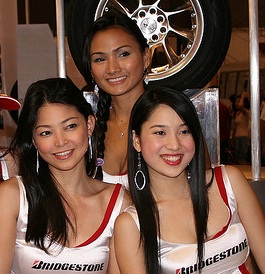First it was President Benigno “Noynoy” Aquino III and his Porsche, now it is Butuan Bishop Juan de Dios Pueblos and the other “Mitsubishops,” proud owners of their Pajeros, considered to be luxury sport utility vehicles (SUVs) in a country with a measly 31 motor vehicles per 1000 people (compared to 273 per 1000 for Malaysia). Perhaps the Philippines inherited its car-crazy culture from its former colonial master, the United States, which leads the world in rate of motor vehicle availability (779 motor vehicles per 1000 people).

Unfortunately, owning a car is beyond the reach of the average Filipino. So most Filipinos are left to being content with displaying their favourite or dream set of wheels as “wallpapers” on their computers or laptops. Those who are fortunate enough to own cars still aspire to pimp their vehicles — make them look flashy and “sporty” — relying on a thriving market for stolen, smuggled, and “chop-chopped” parts which are traded openly in the Philippines. The Metro Manila district of Banawe is a famous haven for trading in such merchandise.
| SUPPORT INDEPENDENT SOCIAL COMMENTARY! Subscribe to our Substack community GRP Insider to receive by email our in-depth free weekly newsletter. Subscribe to our Substack newsletter, GRP Insider! Learn more |
A quick Google search showed that the last googlable reported instance of a crackdown on this sort of open criminal activity in the Philippines was back in 2005 when a police operation in Banawe resulted in the seizure of “a truckload of car parts and the arrest of five dealers of suspected stolen items.” Shortly after, police warned that buyers of stolen car parts face possible arrest. Whether the police made good on such a threat or not is not really debatable as Banawe remains the bastion of a long tradition of Filipino automobile modification art.
A spate of carjackings, kidnappings, and murders this year that involved car dealers brought to light “suspected collusion between the carnapping group [of prime suspect in the crimes, Raymond Dominguez] and some government agencies that help perpetuate their illegal activity.” Such alleged collusion explains why the illegal trade of automobile parts in the Philippines can be conducted with such impunity. It also raises the possibility that many Filipinos who have been customers at one time or another of car modification and repair “services” in places like Banawe may be patrons of the blood car parts trade.
Perhaps Bishop de Dios Pueblos could instead have considered modifying his “seven-year-old car” instead of opting to acquire the latest “sport utility” means of getting from A to B (which got him in trouble after it was found the purchase was funded by taxpayers’ money). Indeed, the honourable bishop’s previous car is considered young by Philippine standards with the average vehicle life in the Philippines estimated to be between 10 to 15 years. This is comparable to the United States and some countries in Western Europe where cars tend to remain on the road over a similar period.
Then again, the last thing the Philippines’ Catholic Bishops need is to be linked to blood car parts the way many Filipino car owners are. Indeed, in a case not too different from this, supermodel Naomi Campbell also found herself in the middle of a media circus after she allegedly accepted “blood diamonds” given to her by former Liberian president Charles Taylor. The Mitsubishops should therefore thank the Lord that they insisted that their SUV’s be delivered brand new.
thumbs up.
Do you have any photo or Image about this new cars?